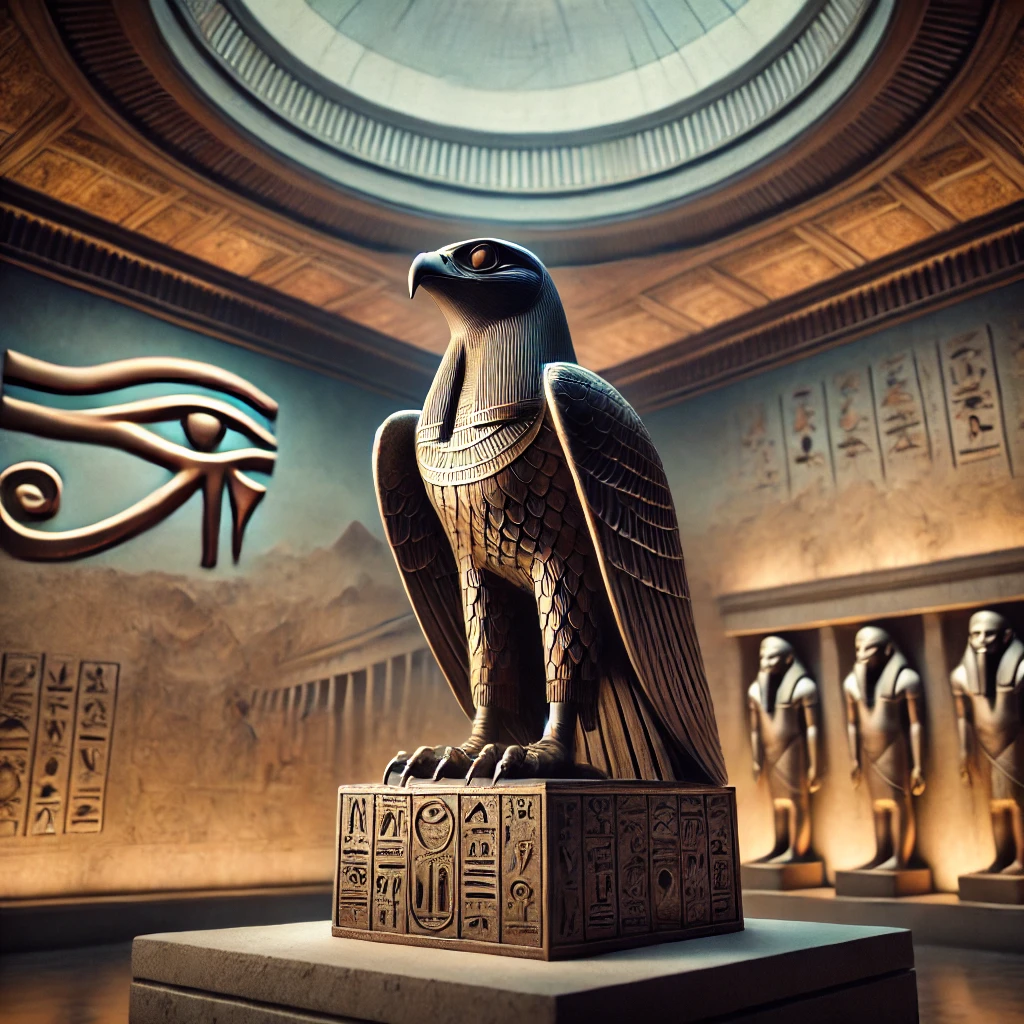Introduction: A Divine Emblem at LACMA
Nestled within the sprawling corridors of the Los Angeles County Museum of Art (LACMA), the Figure of Horus as a Falcon at LACMA stands as a testament to ancient Egyptian civilization’s enduring allure. This exquisite artifact not only captivates visitors with its artistic merit but also serves as a bridge to the mystical world of Egyptian deities, where Horus, the sky god, plays a pivotal role.
Historical Significance of the Figure
Horus, one of ancient Egypt’s most significant deities, is typically depicted as a falcon or a man with the head of a falcon. Revered as the god of the sky, Horus was venerated across Egypt, embodying kingship and protection. The statue at LACMA, dating back thousands of years, represents this connection between the divine and the royal, offering insight into the religious and societal structures of ancient Egypt.
Masterful Craftsmanship of Ancient Times
The craftsmanship of the Horus figure highlights the advanced techniques of ancient Egyptian artisans. Created from precious materials and with meticulous attention to detail, this falcon figure showcases the skill and dedication invested in religious art. Every feather and curve is carved to convey both the god’s majesty and his vital role as a protector of the pharaohs.
Symbolism and Representation: The Falcon Horus
In Egyptian mythology, Horus is often depicted battling with Seth, the god of chaos, illustrating the eternal struggle between order and disorder. The LACMA’s falcon statue, perched with an alert and regal bearing, symbolizes Horus’ vigilant protection over the land and its people, echoing the pharaoh’s role as Egypt’s earthly guardian.
The Falcon: A Symbol of Sovereignty and Vigilance
In ancient Egyptian culture, the falcon was revered not only for its physical prowess but also for its majestic bearing and keen sight—traits idealized in their divine and earthly leaders. The falcon’s sharp eyes, capable of sighting distant prey, were metaphorically linked to the omniscient gaze of Horus, overseeing the expansive lands from the skies. This connection between the falcon’s attributes and the god’s roles illuminates the Egyptians’ deep appreciation for nature and its symbolic potential.
Horus: The Protector of Pharaohs
As a deity, Horus was intrinsically linked to the pharaoh, the living god on Earth. By depicting Horus as a falcon, the artists conveyed his role as the ultimate protector, whose vigilant eyes kept a constant watch over the realm. This portrayal underscored the pharaoh’s dual responsibility to maintain order and protect his people, mirroring Horus’ mythical duties to uphold cosmic balance against the forces of chaos, embodied by Seth, his eternal adversary.
Artistic Expression of Divine Qualities
The Figure of Horus as a Falcon at LACMA, meticulously crafted with an attention to anatomical details and postural accuracy, showcases the ancient Egyptian mastery of translating theological concepts into visual forms. The statue, often poised with a regal demeanor, communicates not only the physical attributes of the falcon but also the divine essence of Horus. Its creation from enduring materials further highlights the permanence and unyielding nature of the gods, reflecting their eternal presence in the lives of the Egyptians.
A Conduit to the Spiritual Realm
The symbolic use of the falcon for Horus also acted as a conduit between the people and the divine. By worshipping a god depicted in a familiar form, the ancient Egyptians felt a closer connection to the celestial powers, making the divine more accessible and less abstract. The Figure of Horus as a Falcon at LACMA thus serves as a testament to the deep interconnections between Egyptian religious practices, their environment, and their social governance.
Interweaving of Egyptian Mythology and Falcon Imagery
The falcon was chosen to represent Horus due to its keen vision and formidable hunting prowess, qualities befitting a ruler. This association underscores the deep connection between nature and divine representation in Egyptian culture, where gods were often depicted as animals to signify their attributes and powers.
The Key Role of Horus in Ancient Egyptian Society
Horus’ significance extends beyond his depiction as a falcon; he was central to the concept of kingship. As the mythical first ruler of Egypt, Horus established the divine right of kings. This belief was integral to the pharaoh’s legitimacy, linking him directly to Horus through the concept of divine kingship, where the pharaoh was seen as Horus incarnate during his reign on earth.
Cultural Synthesis and Evolution in Egyptian Art
The figure at LACMA also reflects the synthesis of various cultural influences over the centuries. Egyptian art evolved through interactions with neighboring cultures, integrating new artistic elements while maintaining its iconic stylistic features. This blend of tradition and innovation is vividly embodied in the Horus statue.
Preservation and Educational Value at LACMA
LACMA’s display of the Horus figure does more than preserve an ancient artifact; it serves as an educational tool that helps demystify Egyptian art and culture for the public. By providing access to such artifacts, LACMA plays a crucial role in cultural preservation and education, helping visitors understand the complexities of ancient societies.
Artistic Legacy and Continuing Inspiration
The artistic legacy of Horus at LACMA is a continual source of inspiration for scholars, artists, and the general public. As a representation of divine oversight and royal power, Horus continues to influence contemporary interpretations of ancient symbols and their relevance to modern cultural discourse.
Conclusion: A Timeless Beacon
The Figure of Horus as a Falcon at LACMA is more than just an artifact; it is a cultural beacon that connects the past with the present, inviting onlookers to search into the wealthy tapestry of old Egyptian mythology. Its display at a major international museum underscores the timeless fascination with Egypt’s ancient civilization and its ability to inspire awe and wonder across ages and cultures.


